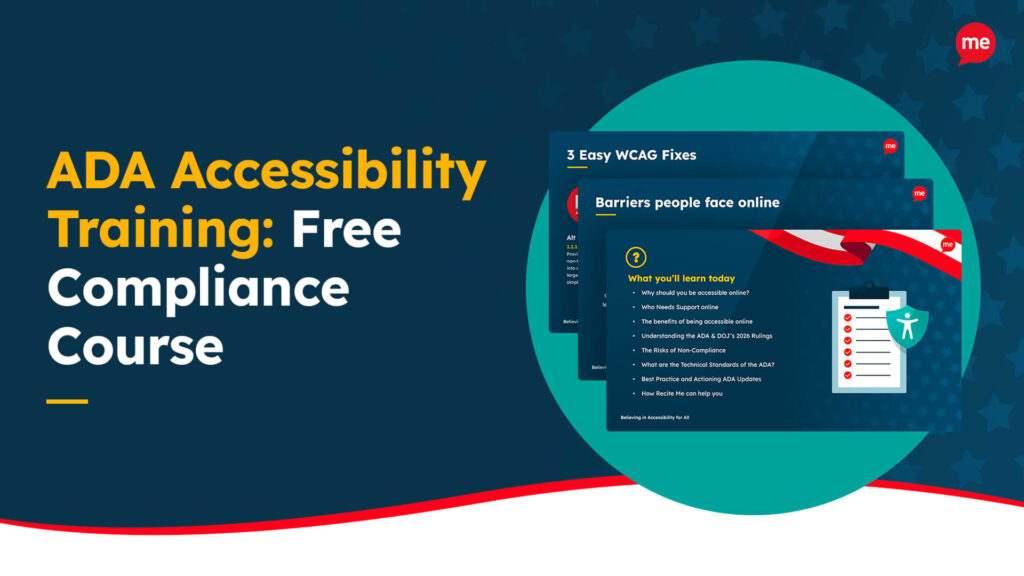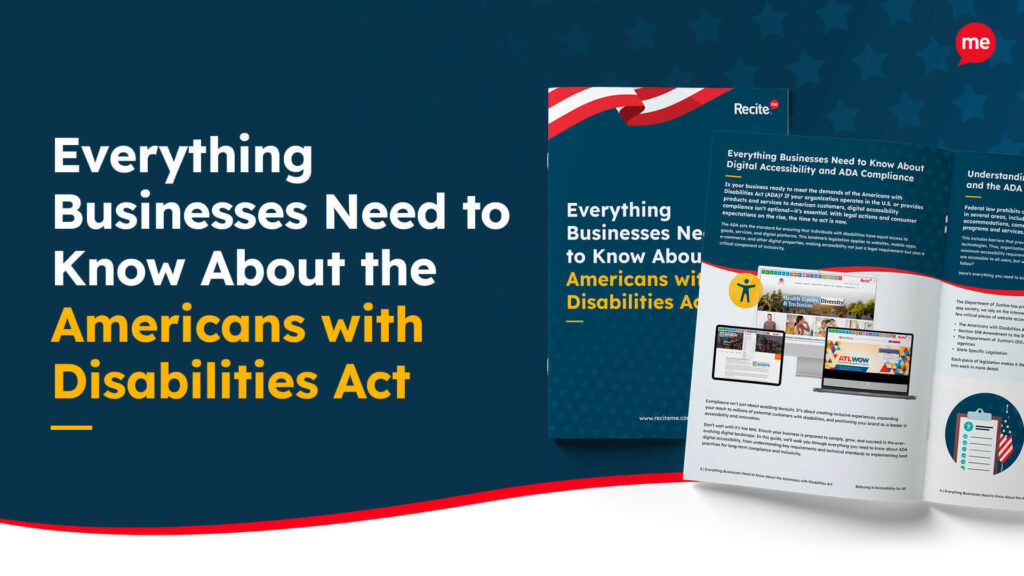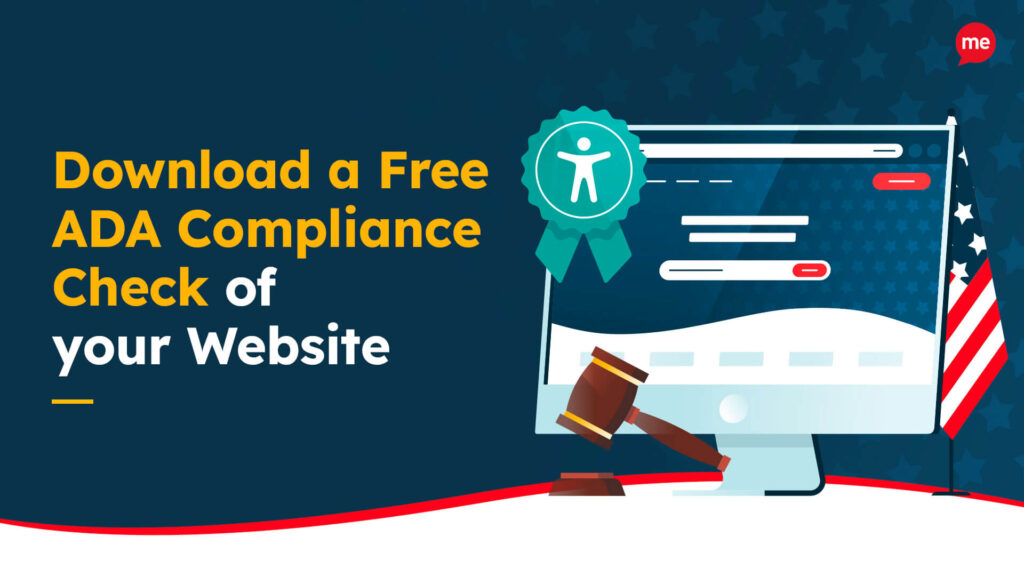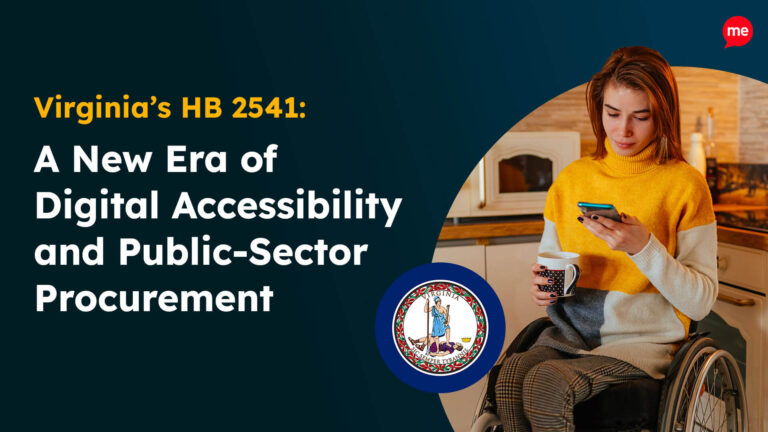Get A Free ADA Compliance Audit Of Your Website
Download NowEnsuring digital accessibility for all has become increasingly essential in recent years. However, for many organizations, the exponential growth of the technology industry, coupled with the continuous proliferation of new online channels and platforms, has made keeping up with the pace of development challenging.
There’s no denying that navigating the myriad of laws and guidelines that govern accessibility can be overwhelming at times, and one of the most significant stumbling blocks is understanding the difference between WCAG and ADA requirements.
You can access information about the differences between WCAG and Section 508 or ADA Vs Section 508 in our previous blogs. But, in this handy guide to ADA vs. WCAG, we’ll kick off with a quick summary before moving on to provide more comprehensive definitions and breakdowns so you can develop plans to foster inclusivity and meet compliance criteria with confidence.
WCAG Vs. ADA: A Comparative Summary
Here’s a quick and easy TL;DR version of the primary differences between WCAG and ADA. We’ll dive into each aspect in more detail in the following sections.
Aspect | WCAG | ADA |
| Authority | W3C | US Congress |
| Legal Framework | International Guidelines | US Federal Civil Rights Law |
| Primary focus | Digital Accessibility | Non-Discrimination in Employment and Public Accommodations |
| Applicability | Global | USA |
| Enforcement | Self-regulation | Department of Justice (DOJ) |
| Compliance levels | A, AA, AAA | Titles I, II, III |
What is WCAG?
The Web Content Accessibility Guidelines (WCAG) are developed and maintained by the World Wide Web Consortium (W3C), an international community that includes various industry experts and member organizations. WCAG provides a framework for making web content accessible to people with disabilities, covering aspects like visual, auditory, motor, cognitive, and neurological disabilities.
There have been several iterations of WCAG since version 1.0 was published in 1999. The most up-to-date version is WCAG 2.2, with WCAG 3.0 expected to be published and become official in the next few years.
What is the ADA?
The Americans with Disabilities Act (ADA), enacted in 1990, is a landmark federal civil rights law prohibiting discrimination against individuals with disabilities in all areas of public life, including employment, education, transportation, and access to public and private services.
Unlike WCAG, the ADA is not explicitly focused on digital accessibility. Rather, it prohibits discrimination against people with disabilities in employment and access to information, products, services, and facilities – both in physical and digital settings. However, the digital accessibility standards outlined in the ADA ensure that online content is equally accessible to everyone.

Free ADA & WCAG Compliance Check of your Website
Detecting ADA & WCAG Compliance issues has never been easier than it is now. At Recite Me we offer a free automated scan of your websites homepage. This will identify and highlight any non-compliance on your website. Followed by recommendations on how to implement the necessary changes to improve your websites accessibility score and standing.
What’s the Difference Between ADA and WCAG?
The key differences between WCAG and ADA lie in legal status, scope, applicability, compliance measures, and enforcement.
WCAG Vs. ADA: Legal Status
WCAG provides international guidelines that have been adopted by most countries as the foundational framework for digital accessibility legislation initiatives. However, although they play a significant role in influencing accessibility standards worldwide, they are not a legal code in their own right. Conversely, the ADA is an official legal code under federal law, with a jurisdiction that extends to all organizations operating within the United States.
WCAG Vs ADA: Scope
The Web Content Accessibility Guidelines are all-encompassing in their focus on digital accessibility. Conversely, only three of the ADA’s five titles are relevant to website accessibility specifically. The others focus on physical-word accessibility requirements and other channels of communication, including stipulations for how telecommunications and broadcasting companies ensure fair and equal services for all.
WCAG Vs ADA: Applicability
WCAG apply in their entirety to all organizations and business types globally, influencing digital accessibility standards beyond the basics of legal requirements. In contracts, each ADA Title affects various types of organizations in different ways. Namely, Title II relates specifically to public sector offices and agencies, while Titles I and III also apply to private and public-facing organizations:
- ADA Title I relates to employment discrimination, mandating digital information regarding recruitment, hiring, promotions, training, job assignments, and termination be accessible to everyone.
- ADA Title II addresses the accessibility of public services, programs, and activities, meaning local governments must make digital information equally available to disabled and non-disabled citizens.
- ADA Title III applies to public-facing businesses, requiring companies to provide full and equal online access to their goods, services, facilities, privileges, advantages, etc.

WCAG Vs ADA: Compliance Measures
The Web Content Accessibility Guidelines are separated into four cornerstone principles, known as the POUR principles, which ensure online content is suitably:
- P = Perceivable: Information must be presented in ways that users can perceive, encompassing various sensory modalities.
- O = Operable: Interface components and navigation must be operable by all users and assistive technologies.
- U = Understandable: Content must be organized logically, using clear language and navigation structures to facilitate comprehension.
- R = Robust: Reliable content interpretation should be possible using a wide range of user agents, including screen readers.
Success criteria across all four POUR principles are separated into three distinct levels of conformance:
- Level A/ Basic – The rudimentary accessibility criteria required to make a website technically accessible.
- Level AA/ Industry Standard – Additional criteria covering the most common accessibility barriers that should be covered to meet an industry-accepted standard.
- Level AAA/ Advanced – Even more additional criteria, which, while desirable, may not be practical or necessary for all websites but represent the highest level of accessibility.
Now, let’s take a look at compliance with specific regard to the ADA.
In designing the ADA legal framework, the US Congress set a benchmark based on compliance with a designated WCAG version, originally WCAG 2.0 Level AA. However, as WCAG version 2.1 Level AA is now the basis of 75% of all federal claims, this has become the expected level of compliance. Legally, that means no organization has to comply with the most up-to-date version of WCAG (version 2.2), nor must they exceed Level AA criteria. However, enhanced compliance efforts are always recommended to avoid unnecessary legal risk.
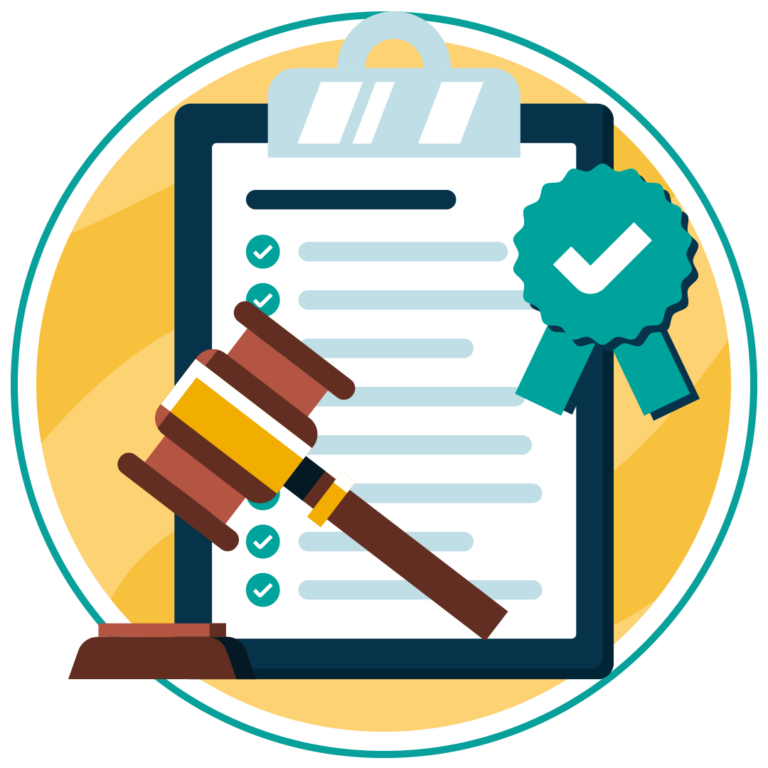
WCAG Vs ADA: Enforcement
WCAG compliance is typically enforced through self-regulation, so there are very few real-world repercussions for non-compliance. In contrast, ADA compliance is overseen by the Department of Justice (DOJ), which investigates complaints and ensures adherence through ADA lawsuits. Organizations found to be in breach of ADA regulations can expect to face serious consequences, including:
- Fines of $55,000 for the first violation, rising to $110,000 for each subsequent violation.
- The revokement of government funding and grants.
- Bills for remedial costs like plaintiff attorney fees, settlements, and court-mandated digital accessibility upgrades.
- Increased regulatory scrutiny moving forward.
Common Misconceptions about WCAG and ADA Compliance
Hopefully, by this point, the fog is lifting and you’re able to understand the difference between WCAG and ADA – and the correlation between them – much more clearly. But before we move on to look at some of the steps you can take to address WCAG and ADA compliance, let’s address a few prevalent myths that could land you in hot legal water.
Myth 1: WCAG Compliance is Optional
Sure, it’s not a legally binding requirement in every jurisdiction in every country. However, compliance with WCAG 2.1 Level AA should be considered the minimum baseline for American organizations, per ADA stipulations.
Myth 2: Only Websites Need to Be ADA Compliant
This is incorrect. Between the various ADA Titles, a broad scope of digital communication mediums are covered to ensure equal access to services, information, and goods for all. While websites are often the primary focus, ADA business requirements also apply to:
- Software applications
- Electronic documents
- Training resources
- Mobile applications
- Kiosks and self-service machines
- Video and multimedia content
- Emails and newsletters
- Intranet and extranet sites
- Customer service chatbots
- Online forms and surveys
- Virtual meeting platforms

Myth 3: Small Businesses Are Exempt from ADA Compliance
This is a half-truth, as there are some (although very few) ADA exemptions. For example, Title I does not apply to organizations with fewer than 15 employees. However, in general, ADA regulations apply universally. So, small businesses are encouraged to implement reasonable accommodations to facilitate accessibility just as much as larger ones – especially because, if found in breach, it’s often much harder for smaller businesses to find funds to cover the potential legal liabilities.
Myth 4: Compliance with WCAG and ADA Means Sacrificing Design and Functionality
In most cases, the opposite is true. Accessibility laws and guidelines emphasize usability enhancements that benefit all users, not just those with disabilities. Therefore, designing with accessibility in mind typically leads to:
- Cleaner interfaces
- Easier navigation
- Improved user engagement
Myth 5: No Further Updates Are Needed Once You Become Compliant
This couldn’t be further from the truth. Digital accessibility is a constantly evolving field. Plus, the information and resources organizations publish online are continually being replaced or updated. So, while achieving initial compliance is an essential step, maintaining accessibility requires ongoing assessment and updates.
Want to make sure your website is compliant with the Americans with Disabilities Act? Then unlock the ADA compliance checklist now. Discover actionable steps to ensure ADA compliance, helping you avoid lawsuits and any other negative consequences of non-compliance.
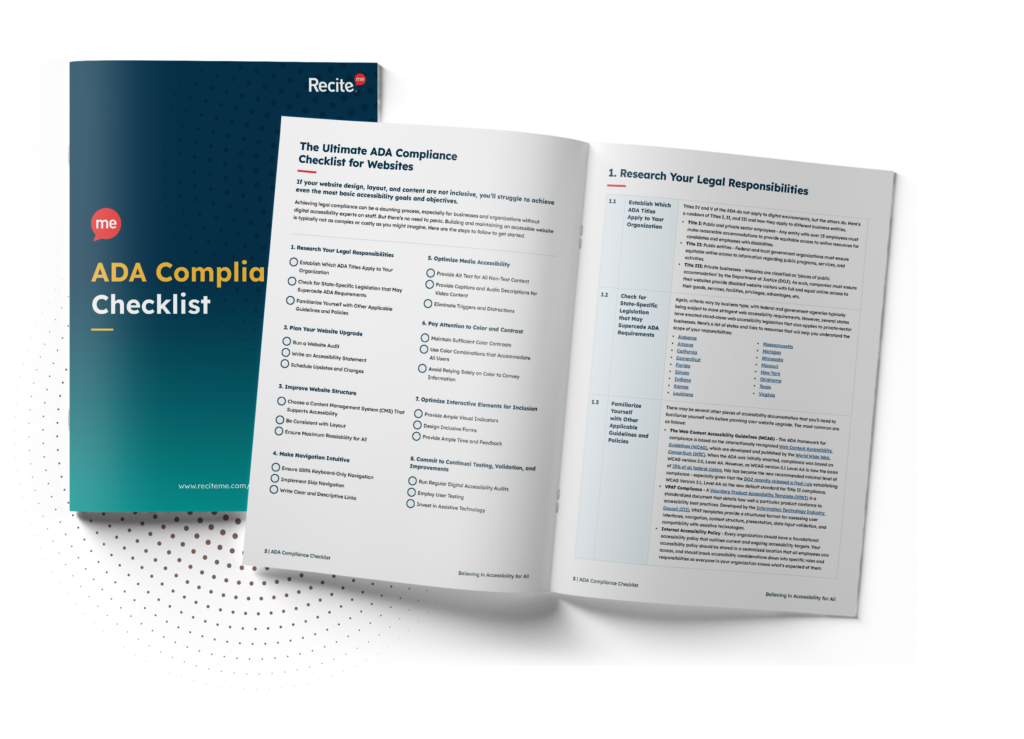
How to Comply with WCAG and ADA Standards
The best way to avoid risk is to be proactive rather than waiting for lawsuits or allegations to arise. To help organizations on their journey to achieving WCAG-based ADA compliance, Recite Me has developed a suite of accessibility-on-demand tools.
1. The Recite Me Accessibility Checker
The Recite Me Accessibility Checker audits back-end and front-end web development processes using 396 separate WCAG-based scans. It swiftly identifies non-compliance issues and generates a prioritized fix queue to get websites up to a legally compliant standard in the fastest possible time frame.
2. The Recite Me Accessibility Toolbar
The Recite Me Accessibility Toolbar promotes inclusivity on an individual user level by allowing website visitors with sight loss, cognitive impairments, learning difficulties, physical disabilities, and varying linguistic needs to make singular or multiple adjustments for ease of navigation and reading.
3. The Recite Me Accessibility Statement Generator
The ADA doesn’t explicitly demand accessibility statements for websites. However, publishing one is considered a best practice. The Recite Me Accessibility Statement Generator provides a simple way to communicate your dedication to current and future digital accessibility goals. Just fill in a quick form, and you’ll have a custom statement ready for immediate upload within minutes.
Need more help becoming ADA compliant?
The following resources are packed full of actionable tips and expert advice for making your digital content compliant with the Americans with Disabilities Act:
Free ADA Accessibility Training
Take the first step to ADA compliance by completing our training course.
Free ADA Accessibility Guide
Ensure your organization is meeting the requirements for ADA compliance.

